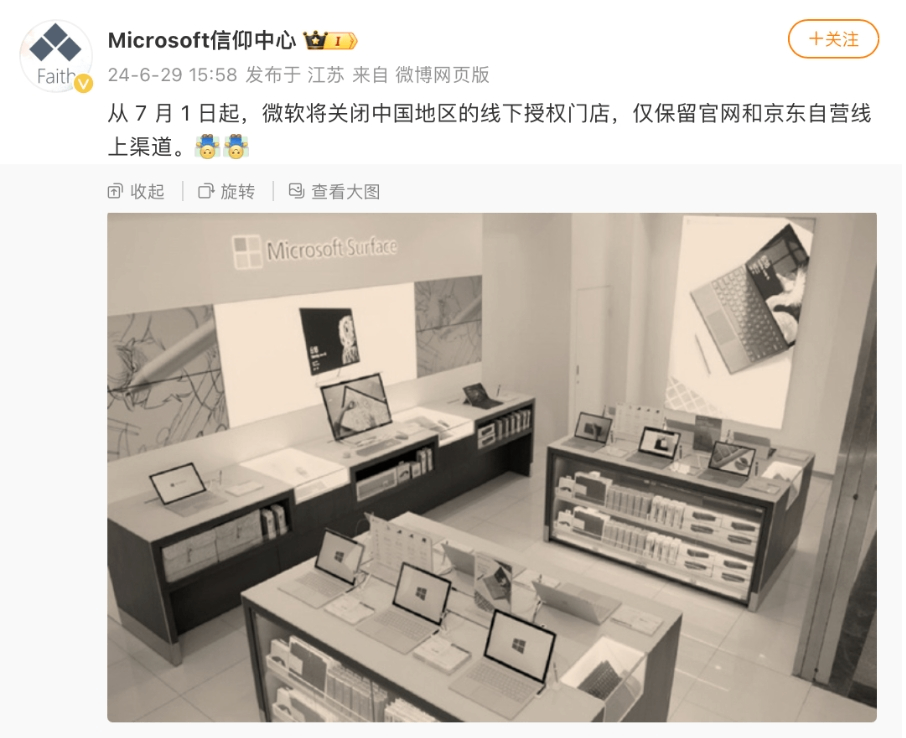Microsoft closes all offline stores in China or related to business adjustment in the new fiscal year
Many large companies will choose to make major organizational changes around the end of the fiscal year to review and restructure their strategies to prepare for the challenges of the new fiscal year.
July 1st, Microsoft China has big news.
Media reports indicate that starting from July 1st, Microsoft will close its offline authorized stores in China, retaining only the official website and the JD.com self-operated online channel. This is also the reason why many consumers found "no samples" in the stores when they went offline to inquire about the Pro 11 / Laptop 7.

Analysts say that the reason for Microsoft's move is that the company is making a "strategic adjustment" to Surface devices globally, and the recognition of Surface by consumers in mainland China "has been declining." In addition, when the media tried to contact Microsoft's authorized stores, the store's phone was always unanswered.
In the midst of doubts, this afternoon, a spokesperson for Microsoft officially responded to the store closure. The spokesperson said that Microsoft constantly evaluates its retail strategy to meet the changing needs of customers and has decided to integrate channels in the mainland China market. Nevertheless, the spokesperson emphasized that customers can still obtain a full range of Microsoft consumer products and services through retail partners and the official Microsoft.com online store.
Microsoft's closure of offline stores this time is likely to be part of the business adjustment for the new fiscal year. It is understood that many large companies will choose to make major organizational adjustments around the end of the fiscal year to review and reorganize their strategies in preparation for the challenges of the new fiscal year.
Microsoft's fiscal year 2024 started last July and ended around the end of June this year. In December last year, Amazon Web Services (AWS) China adjusted its sales team. Now, Microsoft China is also following the pace of AWS China to prepare for its own battle.
It's not just the offline business; there have been previous reports that Microsoft China's Azure business will also undergo significant changes. The specific approach is to integrate small teams with similar functions in various industry sales lines to reduce communication costs and operational inefficiencies caused by the dispersion of forces.
The adjustment of Azure is fully in charge of Hou Yang, the head of Microsoft's Greater China region. Previously, Hou Yang had made a similar attempt in the Digital Native Business Division: Hou Yang once unified the company's CSM team, AE team, and other teams interacting with customers, reporting directly to the general manager of the business division, Tian Zhuo, to reduce communication costs.
Analysts say that although this business adjustment is not expected to lead to large-scale layoffs, as the adjustment continues, Microsoft China may still exhibit characteristics of mergers, streamlining, and flattening, leading to a lack of some middle management positions, especially for front-line managers facing significant challenges.
According to the latest financial report, Microsoft achieved a revenue of $61.9 billion in the third quarter (approximately 448.1 billion yuan), a year-on-year increase of 17%, and a profit of $21.9 billion, an increase of 20%. In the financial report conference call, Microsoft CEO Satya Nadella said that Microsoft is at the forefront of the new era of AI transformation, promoting better business results in all industries.
Microsoft's revenue mainly comes from three departments: the Productivity and Business Processes (Office, LinkedIn, Dynamics) department achieved revenue of $19.6 billion, a year-on-year increase of 12%; the Intelligent Cloud (Azure, Windows Server) department achieved revenue of $26.7 billion, a year-on-year increase of 21%; and the More Personal Computing (Windows, Devices, Gaming) department achieved revenue of $15.6 billion, a year-on-year increase of 17%.
·Original
Disclaimer: The views in this article are from the original Creator and do not represent the views or position of Hawk Insight. The content of the article is for reference, communication and learning only, and does not constitute investment advice. If it involves copyright issues, please contact us for deletion.